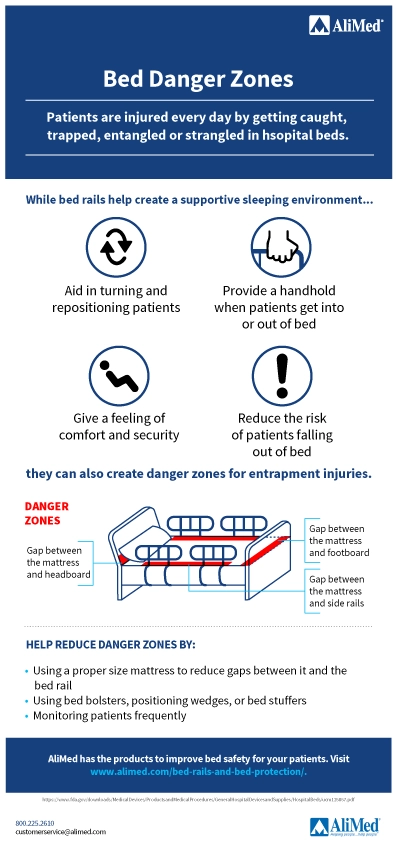Danger Zones in the Bed
Bed rails are used to help create a supportive and assistive sleeping environment in homes, assisted living facilities and residential care facilities. This type of equipment has many commonly used names, including side rails, bed side rails, half rails, safety rails, bed handles, assist bars, or grab bars, hospital bed rails, and adult portable bed rails. When used properly, bed rails provide several benefits such as aiding in turning and repositioning patients, providing a handhold when patients get into or out of bed, giving a feeling of comfort and security, and reducing the risk of patients falling out of bed. However, bed rails should be used with caution, especially with older adults and people with altered mental status, physical limitations and certain medical conditions. Patients are injured every day by getting caught, trapped, entangled, or strangled in hospital beds. The gaps between the mattress and side rails and the mattress and head/footboards are two of the greatest danger zones for entrapment injuries. According to the FDA, between 1985 and January 1, 2009, there were 803 incidents of patients caught, trapped, entangled, or strangled in beds with rails, 480 of whom died as a result.1 Elderly or frail patients may also experience skin tears, cuts, scrapes, and bruising from contact with the hard edges of side rails.
Simple Steps Can Be Taken to Make Bed Rails Safer
There are a variety of bed rails available for use in homes, assisted living facilities, and residential care facilities, such as portable bed rails for adults, portable bed rails for children, and hospital bed rails designed to be attached to a hospital or medical bed. Other names for this equipment include side rails, half rails, safety rails, and bed handles. Some bed rails are considered medical devices and are subject to FDA oversight, while others can be purchased by consumers on websites and in stores without a prescription or in consultation with a health care provider.2 But whether they are being used by a medical professional or layperson, all bed rails should be used with caution, especially with older adults and people with altered mental status, physical limitations, and certain medical conditions. A simple measure to reduce danger zones is using a proper size mattress to reduce gaps between it and the bed rail. In addition, caregivers should consider using transfer or mobility aids, monitoring patients frequently, and anticipating the reasons patients get out of bed such as hunger, thirst, going to the bathroom, restlessness, and pain. These needs can be addressed by providing food and fluids, scheduling regular toilet breaks, and providing calming interventions and pain relief.
AliMed Offers a Variety of Products That Improve Bed Safety for Patients
- AliMed Clear Inflatable Bed Bolsters—Foam bed bolsters may lead to a sense of isolation and helplessness by vulnerable patients. These easily inflatable clear bed bolsters are quickly installed with integral hook and loop ties to protect patients without creating visual isolation.
- AliMed Body Positioning Wedges—These firm foam positioning wedges provide secure side-lying support and trunk stabilization and help prevent pressure injuries. Additionally, the TUFF-COAT® coating helps resist the growth of bacteria and viruses on the surface.
- AliMed® Bed Stuffer Safety Bolsters—These safety bolsters fill the gaps between the mattress and bedrail to eliminate danger zones. They are available in a 36″ length for areas near headboards or footboards, and a 72″ length to fill the gap between the mattress and bed rail.
To learn more about AliMed products for bed protection, please click here.









